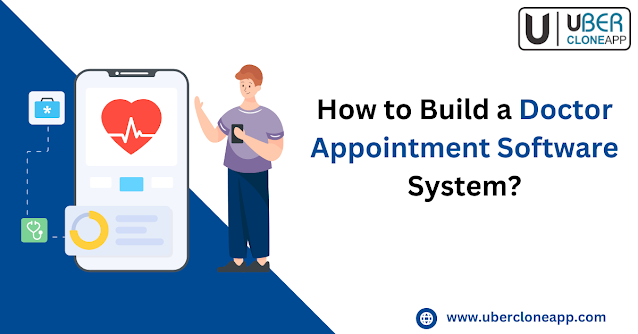How to Build a Doctor Appointment Software System?
Ever had a morning when you woke up feeling sick, but the idea of dealing with complicated appointment systems and long waits at the doctor's office made you cringe? Sadly, this is a common problem for many people around the world. Nearly half of patients skip appointments due to scheduling difficulties. It shows a clear demand and need for easier healthcare access. Here comes an on-demand Doctor Appointment Software.
So, what are we talking about when we say "on-demand doctor app"?
Let's discover creating efficient doctor appointment software, offering both basic and advanced advice for developers and entrepreneurs.
Planning well for a doctor appointment software system that truly fits users' needs is vital.
Understanding Users
Your software serves different groups, each with unique needs:
Patients:
Pain points: Long waits, inconvenient scheduling, lack of online booking, few appointment reminders.
Needs: Easy booking, personalized reminders, telemedicine options, secure doctor chats.
Doctors:
Pain points: Inefficient scheduling, manual data entry, patient flow management issues, communication gaps.
Needs: Flexible scheduling, integrated records, automated reminders, secure messaging.
Clinics:
Pain points: Manual scheduling, administrative burden, data insights lack, scaling challenges.
Needs: Centralized scheduling, reporting tools, automation, seamless software integration. Understanding these viewpoints helps prioritize features for a user-friendly experience.
Advanced Features: Telemedicine, online payments, medical record integration, patient feedback. Ensure compliance with regulations like HIPAA for data security.
Phase 1: Requirements gathering, feature finalization, interface design, architecture planning.
Phase 2: Front-end and back-end development, API integration, and security implementation.
Phase 3: Thorough testing deployment on chosen platforms.
Phase 4: Launch, marketing, support, and ongoing updates based on feedback. Set clear timelines and milestones for each phase.
Choose technologies that fit your budget, team expertise, and scalability needs. Consider:
Front-end: Popular frameworks like React or Vue.js for interactive interfaces.
Back-end: Python-based Django or Node.js with Express for robust server-side logic.
Database: Cloud-based options like MongoDB or PostgreSQL for flexible data storage and scalability.
Make your business more innovative with our Uber clone app!
Time for an exciting development journey! Modern software works best when it can smoothly connect with other systems. Here's how:
Medical Records Integration: Securely access patient information using APIs like FHIR or Direct, with their permission.
Payment Integration: Simplify transactions with secure gateways like Stripe or PayPal, following card data protection standards.
Additional Services: Enhance your software's abilities by integrating with appointment reminders, telemedicine, or lab testing services. Always prioritize data privacy.
- About 78% of patients opt for online appointments.
- Telemedicine market to hit $59.2 billion by 2027 (Fortune Business Insights, 2023).
- On-demand doctor apps: Think Uber for healthcare! These mobile applications connect patients with doctors for immediate consultations, virtual visits, or in-person appointments.
- Doctor booking scripts: These pre-written codes provide a foundation for building appointment scheduling features within existing software solutions used by clinics or hospitals.
Let's discover creating efficient doctor appointment software, offering both basic and advanced advice for developers and entrepreneurs.
Pre-development Planning
Planning well for a doctor appointment software system that truly fits users' needs is vital.
Understanding Users
Your software serves different groups, each with unique needs:
Patients:
Pain points: Long waits, inconvenient scheduling, lack of online booking, few appointment reminders.
Needs: Easy booking, personalized reminders, telemedicine options, secure doctor chats.
Doctors:
Pain points: Inefficient scheduling, manual data entry, patient flow management issues, communication gaps.
Needs: Flexible scheduling, integrated records, automated reminders, secure messaging.
Clinics:
Pain points: Manual scheduling, administrative burden, data insights lack, scaling challenges.
Needs: Centralized scheduling, reporting tools, automation, seamless software integration. Understanding these viewpoints helps prioritize features for a user-friendly experience.
2. Focus on crucial features:
Core Features: Secure booking, personalized reminders, appointment changes, and secure communication.Advanced Features: Telemedicine, online payments, medical record integration, patient feedback. Ensure compliance with regulations like HIPAA for data security.
3. Planning Development
Phase 1: Requirements gathering, feature finalization, interface design, architecture planning.
Phase 2: Front-end and back-end development, API integration, and security implementation.
Phase 3: Thorough testing deployment on chosen platforms.
Phase 4: Launch, marketing, support, and ongoing updates based on feedback. Set clear timelines and milestones for each phase.
4. Technology Evaluation
Choose technologies that fit your budget, team expertise, and scalability needs. Consider:
Front-end: Popular frameworks like React or Vue.js for interactive interfaces.
Back-end: Python-based Django or Node.js with Express for robust server-side logic.
Database: Cloud-based options like MongoDB or PostgreSQL for flexible data storage and scalability.
Make your business more innovative with our Uber clone app!
On-demand doctor app development
Time for an exciting development journey! Modern software works best when it can smoothly connect with other systems. Here's how:
Medical Records Integration: Securely access patient information using APIs like FHIR or Direct, with their permission.
Payment Integration: Simplify transactions with secure gateways like Stripe or PayPal, following card data protection standards.
Additional Services: Enhance your software's abilities by integrating with appointment reminders, telemedicine, or lab testing services. Always prioritize data privacy.
Compliance with Privacy Laws: If users are from varied areas, ensure compliance with GDPR and CCPA privacy regulations.
Simplify: Focus on clear navigation and fewer steps.
Accessibility: Follow guidelines for color, font, and navigation.
Appealing Design: Create a modern, clean look with intuitive icons.
Cater to All: Consider disabilities and cultural differences.
If a web app is part of your plan:
User experience is crucial. Make your interface outstanding by:
Simplify: Focus on clear navigation and fewer steps.
Accessibility: Follow guidelines for color, font, and navigation.
Appealing Design: Create a modern, clean look with intuitive icons.
Cater to All: Consider disabilities and cultural differences.
Decide how to build your mobile app:
- Provides excellent performance but requires separate code for iOS and Android platforms.
- Cross-platform Development (like React Native) - Develop once and use on both iOS and Android, though it may be slightly slower.
- Consider your budget, team skills, and user demographics.
If a web app is part of your plan:
- Verify the app works well on desktops, tablets, and smartphones.
- Improve doctor appointment software with PWAs for offline access and notifications, blending web and mobile functions.
Testing software from launch to maintenance
Before introducing your software to the world, thorough testing is vital. Here's what to focus on:- Unit Testing: Check that each part works correctly on its own.
- Integration Testing: Confirm that different parts work well together.
- Security Testing: Identify and resolve vulnerabilities to safeguard user data from cyber risks.
- Usability Testing: Collect user input to enhance the interface and usability.
- Cross-Platform Testing: Assess performance across different devices and platforms for consistency.
Beta Testing: Before the official launch, involve a small group of users in a closed beta test. This helps you:
Now it's time to release your Doctor Appointment Software! Select the best platform based on your audience:
Your launch is just the beginning. Here's how to keep improving your software:
- Spot remaining issues and get feedback on features and usability.
- Make final tweaks and improve your software based on real-world use.
Now it's time to release your Doctor Appointment Software! Select the best platform based on your audience:
- App Stores (iOS, Android): Reach mobile users through official app stores.
- Web Hosting Providers: Pick a reliable service for your web-based software.
- Private Cloud/Server Deployment: Consider this option for specific business needs or particular user groups.
Your launch is just the beginning. Here's how to keep improving your software:
- Marketing Efforts: Use SEO, social media, and ads to attract users.
- Maintenance: Update regularly, fix bugs, and address security issues promptly.
- Feedback Loop: Keep gathering feedback to make continuous improvements.
- Future Plans: Consider adding telemedicine and AI to improve user experience.




Comments
Post a Comment